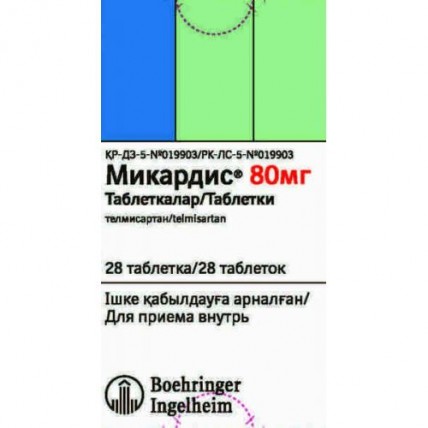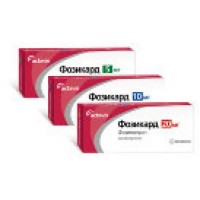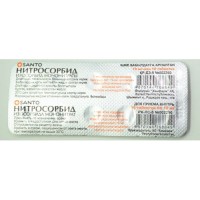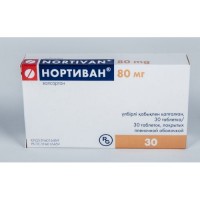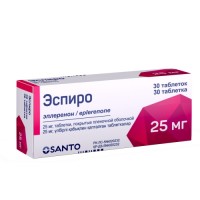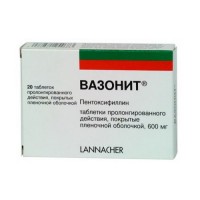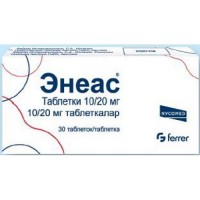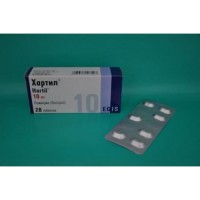Micardis® Plus (Telmisartan) 80 mg/12.5 mg, 28 tablets
- $27.10
Sku:
2afcc9ff3d17
The instruction for medical use of Mikardis® medicine Trade name МИКАРДИС® the International unlicensed name Telmisartan Lekarstvennaya a form of the Tablet of 80 mg One tablet contains Structure: active agent – telmisartan 80 mg, excipients: sodium hydroxide, K 25 povidone, meglumin, P6 sorbitol, magnesium stearate. The description of the Tablet of oblong shape, white or almost white color, with marking 52H on one party and a logo of the company on another, with a biconvex surface, 4.4 - 5.0 mm thick. Pharmacotherapeutic group Drugs for treatment of diseases of a cardiovascular system. The drugs influencing a system renin-angiotensin. Angiotensin II antagonists. Telmisartan. The ATX C09CA07 code the Pharmacological Telmisartan Pharmacokinetics Absorption properties is quickly soaked up, the absorbed quantity varies. The average absolute bioavailability of a telmisartan is about 50%. At reception of a telmisartan along with food the decrease in AUC (the area under a curve concentration time) fluctuates from 6% (at a dose of 40 mg) up to 19% (at a dose of 160 mg). 3 hours later after reception the concentration in blood plasma is leveled, irrespective of meal. Linearity/nonlinearity does not lead Insignificant decrease in AUC to decrease in therapeutic effectiveness. The linear dependence between doses and levels in plasma is absent. Smaks. and, to a lesser extent, AUC disproportionately increase at doses higher than 40 mg. Distribution Communication with proteins of plasma more than 99.5%, generally with albumine and alpha 1-acid ether of a glycoprotein. The average seeming equilibrium volume of distribution is about 500 l. Biotransformation Telmisartan is metabolized by a konjyugirovaniye of initial substance with a glucuronide. The pharmacological activity of a conjugate is not found. Removal Telmisartan has the biexponentsialny nature of pharmacokinetics with terminal elimination half-life & gt, 20 hours. Cmax and – to a lesser extent – AUC increase disproportionately with a dose. Clinically significant cumulation of a telmisartan is not found. Concentration of a telmisartan in plasma at women were higher, than men, however it had no significant impact on its efficiency. After peroral (and intravenous) reception telmisartan it is almost completely removed through intestines in not changed look. The general excretion with urine is less than 1% of a dose. The general plasma clearance high (about 1000 ml/min.) in comparison with a hepatic blood-groove (about 1500 ml/min.). Special groups of patients Patients of children's age the Pharmacokinetics of two introductions of a telmisartan was estimated at patients with hypertensia (n = 57) aged from 6 up to 18 years after reception of a telmisartan in doses of 1 mg/kg or 2 mg/kg during the four-week period of treatment. Results of a research confirmed that indicators of pharmacokinetics of a telmisartan at children are aged younger than 12 years correspond to that at adults and, in particular, the nonlinear nature of Cmax was confirmed. Paul Nablyudalis of difference in concentration in plasma, at the same time Smaks. and women had AUC approximately in 2 and 3 times is higher in comparison with men respectively. Patients of advanced age Pharmacokinetics of a telmisartan at patients of advanced age and persons are younger than 65 years does not change. Patients with a renal failure At patients with a slight, moderate and heavy renal failure the doubling of concentration in plasma was observed. At persons with a renal failure telmisartan contacts proteins of plasma more and it is not removed at dialysis. In a renal failure the elimination half-life does not change. Patients with a liver failure At patients with a liver failure the absolute bioavailability of a telmisartan increases to 100%. Elimination half-life in a liver failure does not change. A pharmacodynamics of MIKARDIS it is effective at oral administration and is a specific (selection) antagonist of receptors of angiotensin II (AT1 type). Telmisartan forces out angiotensin II with high affinity to receptors of AT1 subtype, responsible for the known effect of angiotensin II. Telmisartan does not show partial agonistic activity concerning receptor AT1. Telmisartan selectively contacts AT1 receptors. Communication has long character. Telmisartan does not show affinity to other receptors, including to AT2 to a receptor and another, less studied by AT receptors. The functional value of these receptors and also effect of their possible excess stimulation by angiotensin II which concentration increases when assigning a telmisartan, are not studied. Telmisartan reduces Aldosteronum level in plasma, does not block renin in plasma of the person and ion channels. Telmisartan does not inhibit angiotensin-converting enzyme (kinase of II) which destroys bradykinin. Therefore there is no strengthening of the side effects connected with effect of bradykinin. At the person the dose of a telmisartan of 80 mg almost completely inhibits the increase in the arterial blood pressure (ABP) caused by angiotensin II. The inhibitory effect is maintained within 24 hours and is defined till 48 o'clock. Clinical performance and safety Treatment of a hypertension After reception of the first dose of a telmisartan of the ABP decreases in 3 hours. The maximum decrease in the ABP is gradually reached in 4-8 weeks after an initiation of treatment and supported during the entire period of treatment. Hypotensive action continues within 24 hours after administration of drug, including 4 hours before reception of the next dose that is confirmed by out-patient measurements of the ABP and also steady (it is higher than 80%) ratios of the minimum and maximum concentration of drug after reception of 40 and 80 mg of drug MIKARDIS in placebo - controlled clinical trials. MIKARDIS at patients with hypertensia reduces both systolic, and diastolic pressure without change of heart rate. The contribution of diuretic and natriuretic effect of medicine to its hypotensive activity still should be defined. Antihypertensive action of a telmisartan was compared to representatives of other classes of hypotensive drugs, such as: amlodipin, atenolol, enalapril, hydrochlorothiazide, lisinopril. In case of the sharp termination of administration of drug MIKARDIS AD gradually returns to values before treatment within several days without signs of fast resuming of arterial hypertension (there is no syndrome of ricochet). In multicenter international clinical trials it was proved what cases of dry cough the patients accepting telmisartan had much less, than at the patients receiving inhibitors of angiotensin-converting enzyme (iAPF). Prevention of the cardiovascular phenomena In the research ONTARGET (the current research of a telmisartan as monotherapy and to combinations with ramiprily) comparison of action of a telmisartan, ramipril and combination of a telmisartan and ramipril on the cardiovascular phenomena at patients at the age of 55 years was carried out and is more senior with coronary heart disease, a stroke, the tranzitorny ischemic attack, a disease of the peripheral arteries or diabetes of the 2nd type which are followed by injury of target organs (for example, a retinopathy, a hypertrophy of a left ventricle, macro - or a microalbuminuria) in the anamnesis which represent population with risk of the cardiovascular phenomena. Telmisartan showed the effect similar to a ramipril, in relation to decrease to primary combined final point: cardiovascular death, not fatal heart attack, not fatal stroke or hospitalization concerning stagnant heart failure. Frequency of primary final point was similar in groups of a telmisartanaa of a ramipril. The relation of risks for a telmisartan in comparison with ramiprily made 1.01. Mortality frequency from all reasons was 11.6% and 11.8% among the patients receiving telmisartan and ramiprit respectively. The similar efficiency of a telmisartan and ramipril in relation to predetermined a secondary final point was found: cardiovascular death, not fatal myocardial infarction and not fatal stroke, to the key final indicator in the reference research HOPE (research on assessment of prevention of the cardiological phenomena) in which investigated effect of a ramipril in comparison with placebo. In a research of TRANSCEND randomized patients with intolerance of ACE-I of patients with the other criteria of inclusion similar to the research ONTARGET, in the groups receiving 80 mg of a telmisartan (n = 2954) or placebo (n = 2972) in addition to standard treatment. The average duration of the subsequent observation was 4 years 8 months. Significant differences in frequency of primary combined final point (cardiovascular death, not fatal myocardial infarction, a nefalny stroke or hospitalization because of stagnant heart failure) are not revealed. The evidence of positive influence of a telmisartan in comparison with placebo on a predetermined secondary final point (cardiovascular death, not fatal myocardial infarction and not fatal stroke) is obtained. There were no proofs of positive influence on rate of mortality from the cardiovascular phenomena. Cough and a Quincke's edema were registered at the patients accepting telmisartan, less often than at the patients receiving ramiprit whereas hypotension was registered at reception of a telmisartan more often. Use of a telmisartan in a combination with ramiprily does not provide additional favorable effect in comparison with use of a ramipril or telmisartan separately. Rates of mortality from the cardiovascular phenomena and from all reasons were in number higher at the combined treatment. Besides, in the group receiving the combined treatment were noted much the increased frequency of a hyperpotassemia, a renal failure, hypotension and faints. Therefore use of a combination of a telmisartan and ramipril in this group of patients is not recommended. In the research PRoFESS (Scheme of effective prevention of the second stroke) at patients at the age of 50 years is also more senior, recently had a stroke, the increased sepsis frequency in group of a telmisartan in comparison with placebo - 0.70% in comparison with 0.49% is noted, the frequency of cases of sepsis from the death was increased at the patients accepting telmisartan (0.33%), in comparison with the patients accepting placebo (0.16%). The observed increased sepsis frequency associated with use of a telmisartan can be the accidental phenomenon or can be connected with the mechanism unknown now. In two large randomized controlled studies (ONTARGET and VA NEPHRON-D (the nephropathy research in diabetes conducted by the Veterans Affairs Committee)) studied use of a combination of APF inhibitor with angiotensin II receptor blocker. The research ONTARGET was carried out with participation of patients with cardiovascular and cerebrovascular diseases or the diabetes of the 2nd type which was followed by signs of damage of target organs in the anamnesis. You see more detailed information above under the heading Prevention of the Cardiovascular Phenomena. The research VA NEPHRON-D was carried out with participation of patients with diabetes of the 2nd type and a diabetic nephropathy. These researches showed lack of significant favorable impact on the renal and/or cardiovascular phenomena and mortality while the increased risk of a hyperpotassemia, an acute renal failure and/or hypotension in comparison with monotherapy was observed. Considering their similar pharmakodinamichesky properties, these results are also relevant for other APF inhibitors and blockers of receptors of angiotensin II. Therefore APF inhibitors and blockers of receptors of angiotensin II should not be used at the same time at patients with a diabetic nephropathy. (A research of an aliskiren in type 2 diabetes with use of the final indicators concerning cardiovascular diseases and diseases of kidneys) definition of advantage of addition of an aliskiren to standard therapy with use of APF inhibitor or a blocker of a receptor of angiotensin II at patients with diabetes of the 2nd type and a chronic disease of kidneys and/or a cardiovascular disease was ALTITUDE research objective. The research was ahead of schedule stopped because of the increased risk of failures. Death frequency from the cardiovascular phenomena and a stroke was in number increased in group of an aliskiren in comparison with group of placebo, and the studied undesirable and serious undesirable phenomena (hyperpotassemia, hypotension and dysfunction of kidneys) were registered in group of an aliskiren more often, than in group of placebo. Children Safety and efficiency of drug MIKARDIS at children and teenagers aged up to 18 years are not established. A lowering of arterial pressure under the influence of two doses of a telmisartan estimated at 76 patients with hypertensia and excess weight aged from 6 to & lt, 18 years (body weight ≥ 20 kg and ≤ 120 kg, on average 74.6 kg) after reception of 1 mg/kg (n = 29) or 2 mg/kg of a telmisartan (n = 31) during the four-week period of treatment. At inclusion in a research the presence of secondary hypertensia was not studied. Some patients had applied doses above the recommended doses at treatment of hypertensia at adults and reached the daily dose comparable from 160 mg which was studied at adults. After correction on age effects the average change the GARDEN in comparison with initial level (main objective) was-14.5 (1.7) mm Hg. in group of 2 mg/kg of a telmisartan,-9.7 (1.7) mm Hg. in group of 1 mg/kg of a telmisartan and 6.0 (2.4) in group of placebo. The corrected changes of diastolic arterial blood pressure in comparison with initial level were-8.4 (1.5) mm Hg.,-4.5 (1.6) mm Hg. and 3.5 (2.1) mm Hg. respectively. Change of the ABP depended on a drug dose. The data on safety received in this research at patients aged from 6 up to 18 years, as a rule, were similar to the data obtained at adults. Safety of long-term treatment using a telmisartan at children and teenagers was not estimated. The increase in quantity of eosinophils registered in this group of patients was not noted at adults. Its clinical value and the importance are unknown. These clinical data do not allow to make the conclusion about efficiency and safety of a telmisartan at children with hypertensia. Indications Hypertensia - treatment of a hypertension at adults Prevention of the cardiovascular phenomena Decrease in cardiovascular incidence at adults with: - manifestation of an aterotrombotichesky cardiovascular disease (coronary heart disease, a stroke or a disease of peripheral arteries in the anamnesis), - diabetes of the 2nd type with documentary confirmed damage of a target organ. A route of administration and doses the Dosage Treatment of a hypertension the Recommended dose for adults makes 40 mg once a day. Some patients can gain favorable effect from a daily dose of 20 mg. In cases when the desirable of the ABP is not reached, the dose of drug MIKARDIS can be increased to the maximum 80 mg once a day. Telmisartan it is possible to use in a combination with thiazide diuretics, for example, a hydrochlorothiazide which in combination with telmisartany renders additional hypotensive effect. At increase in a dose it is necessary to take into account that the maximum antihypertensive effect is usually reached within four-eight weeks after an initiation of treatment. Prevention of the cardiovascular phenomena the Recommended dose makes 80 mg once a day. It is not found out whether doses lower than 80 mg are effective for decrease in cardiovascular incidence. At the initial stage of use of a telmisartan for prevention of cardiovascular incidence and mortality the control of the arterial blood pressure (ABP) is recommended and also correction of the ABP the medicines lowering the arterial blood pressure can be necessary. Special groups of patients the Renal failure Experience of use for patients with a heavy renal failure or a hemodialysis is limited. For these patients lower initial dose of 20 mg is recommended (see the section Special Instructions). For patients with a slight or moderate renal failure the dose adjustment is not required. A liver failure of MIKARDIS it is contraindicated to patients with heavy dysfunctions of the furnace
and (see the section Contraindications). At patients with slight and moderate abnormal liver functions the daily dose of drug should not exceed 40 mg once in day. Elderly patients Dose adjustment is not required. Children Safety and efficiency of use of drug MIKARDIS for children and teenagers up to 18 years is not established. A route of administration of Tablet MIKARDIS are intended for oral administration with liquid, with food or without it once a day. The precautionary measures taken before treatment of medicine or its use Telmisartan should be stored in the tight blister because of hygroscopicity of tablets. Tablets should be got from the blister just before reception. Side effects Summary information on safety profile Serious undesirable reactions to drug include anaphylactic reaction and a Quincke's edema which can seldom meet (from 1/10,000 to & lt, 1/1000), and an acute renal failure. In placebo - controlled researches at patients with arterial hypertension the total number of side effects about which it is reported at reception of a telmisartan (41.4%) is usually comparable to the number of the side effects arising at intake of placebo (43.9%). This number of side effects was not dose-dependent, was not connected with a sex, age or race of patients. The profile of safety of drug MIKARDIS at the patients taking the drug for prevention of cardiovascular diseases corresponded to safety profile for patients with arterial hypertension. The listed below side effects were received as a result of controlled clinical trials in which patients with hypertensia and also from post-market researches participated. Besides, serious side effects and side effects which led to the termination of administration of drug, about which it was reported in three long-term clinical trials conducted with participation of 21,642 patients accepting telmisartan for prevention of cardiovascular diseases within six years are included. The undesirable phenomena are given below with use of the following classification: often ≥1/100 to & lt, 1/10, infrequently ≥1/1000 to & lt, 1/100, is rare ≥1/10000 to & lt, 1/1000, also lt, 1/10000 is very rare. Infections and invasions: Infrequently: Seldom: infections of urinary tract (including cystitis), upper respiratory tract infections sepsis (including cases with a lethal outcome) 1 Disturbances from blood and lymphatic system: Infrequently: Seldom: anemia an eosinophilia, Disturbance thrombocytopenia from the immune system: Seldom: hypersensitivity, anaphylactic reactions of Disturbance of metabolism: Infrequently: Seldom: a hyperpotassemia a hypoglycemia (at patients with diabetes) Mental disturbances: Infrequently: insomnia, depression Seldom: feeling of concern of Disturbance from the central nervous system: Infrequently: syncope Seldom: drowsiness of Disturbance from organs of sight: Seldom: visual disorders of Disturbance from an organ of hearing and a vestibular mechanism Infrequently: Disturbance dizziness from a cardiovascular system: Infrequently: bradycardia Seldom: tachycardia Vascular disorders: Infrequently: gipotenziya2, orthostatic hypotension of Disturbance from respiratory organs: Infrequently: short wind, cough Very seldom: An interstitial disease legkikh4 Disturbances from digestive tract: Infrequently: abdominal pain, diarrhea, dyspepsia, meteorism, vomiting Seldom: discomfort in a stomach, dryness in a mouth, the Disturbance dysgeusia from a liver and biliary tract: Seldom: dysfunction of a liver / hepatic rasstroystva3 Disturbances from skin and hypodermic fabrics: Infrequently: Itching, perspiration, rash Seldom: a Quincke's disease (up to lethal outcomes), eczema, an erythema, urticaria, medicinal dermatitis, toxic rash of Disturbance from the musculoskeletal system and connective tissue: Infrequently: dorsodynia (for example, sciatica), muscular spasms, myalgia Seldom: arthralgia, extremity pain, sinew pain (tendinitopodobny symptoms) of the Renal failure and urinary tract: Infrequently: a renal failure, including an acute renal failure the General disorders: Infrequently: thorax pain, asthenia (weakness) Seldom: grippopodobny syndrome of Change of laboratory indicators: Infrequently: increase in level of creatinine in blood Is rare: decrease in level of hemoglobin, increase in concentration of uric acid in blood, increase in activity of hepatic enzymes, increase in concentration of a kreatinfosfokinaza (KFK) in blood 1,2,3,4: the additional description see in the subsection Description of Separate Side Effects Description of Separate Side Effects Sepsis In the research PRoFESS observed the increased sepsis frequency at reception of a telmisartan in comparison with placebo. This phenomenon can be accidental or connected with the mechanism unknown now (see also section Pharmacodynamics). Hypotension This undesirable reaction was registered as frequent at the patients with controlled arterial blood pressure receiving telmisartan for decrease in cardiovascular diseases against the background of standard treatment. Disturbance/disorder of function of a liver the Majority of cases of disturbance/disorder of function of a liver during post-registration experience were observed at patients in Japan who more likely experience these undesirable reactions. The interstitial disease of lungs during post-registration study was reported about temporary interrelation of an interstitial disease of lungs with administration of drug of MIKARDIS. At the same time the causal interrelation is not established. The message about the suspected undesirable reactions the Message about the suspected undesirable reactions after registration of medicine is important. It allows to carry out continuous monitoring of a ratio advantage/risk for medication. We ask workers of health care to report about any suspected undesirable reactions. Contraindications - hypersensitivity to a telmisartan or to any of drug components - obstructive diseases of bilious ways - a heavy liver failure - joint administration of drug of MIKARDIS and the drugs containing aliskiren at patients with diabetes or a renal failure (SKF & lt, 60 ml/min. / 1.73 sq.m) - rare hereditary intolerance of fructose - pregnancy and the period of a lactation - children's and teenage age up to 18 years Medicinal interactions Digoxin At combined use of a telmisartan with digoxin observed increase in median value peak (49%) and the minimum concentration of digoxin in plasma (20%). At initiation, correction and the termination of reception of a telmisartan it is necessary to control digoxin level, supporting its level within therapeutic range. As well as other medicines operating on renin-angiotensin-aldosteronovuyu a system telmisartan can provoke a hyperpotassemia (see the section Special Instructions). The risk can increase in case of use of a combination with other medicines which can also provoke a hyperpotassemia (kaliysoderzhashchy substitutes of salt, kaliysbergayushchy diuretics, APF inhibitors, antagonists of a receptor of angiotensin II, non-steroidal anti-inflammatory drugs (NPVP, including selection TsOG-2 inhibitors), heparin, immunodepressants (cyclosporine or takrolimusy) and Trimethoprimum). Emergence of a hyperpotassemia depends on the related risk factors. The risk increases in case of above-mentioned combinations of medicines. This risk is especially high when using a combination with kaliysberegayushchy diuretics and kaliysoderzhashchy substitutes of salt. For example, the combination with APF or NPVP inhibitors represents smaller risk on condition of strict observance of precautionary measures. Simultaneous use is not recommended Kaliysberegayushchy diuretics or additives on the basis of potassium Antagonists of a receptor of angiotensin II, for example, telmisartan, weaken the potassium loss caused by diuretics. Kaliysberegayushchy diuretics, for example spirinolakton, eplerenon, or kaliysoderzhashchy substitutes of salt can lead Triamterenum or amiloride, additives on the basis of potassium to significant increase in level of potassium in serum. If combined use is necessary according to indications of a documentary hypopotassemia, they should be used with care and on condition of frequent control of level of potassium in serum. Lithium Reversible increase in toxicity and concentration of lithium in serum is registered during the accompanying use of lithium and inhibitors of angiotensin-converting enzyme and also antagonists of a receptor of angiotensin II, including a telmisartan. If use of this combination is necessary, careful monitoring of level of lithium in serum is recommended. The combined use demanding care NPVP Non-steroidal anti-inflammatory drugs (i.e. acetylsalicylic acid in anti-inflammatory medicinal schemes, TsOG-2 inhibitors and non-selective NPVP) can reduce antihypertensive action of antagonists of a receptor of angiotensin II. At some patients with a renal failure (for example, patients with dehydration or elderly patients with a renal failure) joint introduction of antagonists of a receptor of angiotensin II and agents who inhibit cyclooxygenase can lead to a further renal failure up to an acute renal failure which is potentially reversible. Thus, this combination should be applied with care, especially at elderly patients. Patients have to have a sufficient level of hydration, and it is necessary to pay attention to control of a condition of function of kidneys after the beginning of the accompanying medicinal therapy and also periodically at later stages. In one research the joint introduction of a telmisartan and ramipril led to 2.5-fold increase in PPK0-24 and Smaks. ramipril and ramiprilat. The clinical value of this observed effect is unknown. Diuretics (thiazide or loopback diuretics) the Previous treatment using high doses of diuretics, for example furosemide (loopback diuretic) and Hydrochlorthiazidum (thiazide diuretic) can lead to dehydration and emergence of risk of developing hypotension at an initiation of treatment using a telmisartan. It is necessary to take into account at combined use Other antihypertensive agents Hypotensive action of a telmisartan can amplify due to combined use of other antihypertensive medicines. Data of clinical trials showed that double blockade the system renin-angiotensin-aldosteronovoy (SRAA) due to sharing of APF inhibitors, blockers of a receptor of angiotensin II or an aliskiren is associated with higher frequency of such undesirable phenomena as hypotension, a hyperpotassemia and depression of function of kidneys (including an acute renal failure) in comparison with use of the single agent acting on RAAS. On the basis of their pharmacological properties it is possible to expect that the following medicinal products can enhance hypotensive effect of all antihypertensive drugs, including telmisartan: Baclofenum, amifostin. Besides, orthostatic hypotension can be aggravated at the expense of alcohol, barbiturates, drugs or antidepressants. Corticosteroids (system use) Decrease in antihypertensive action. Patients should not appoint special indications of the Abnormal liver function of MIKARDIS with a cholestasia, obstructive disorders of bilious ways or a heavy abnormal liver function as telmisartan it is removed generally with bile. At these patients the decrease in hepatic clearance of a telmisartan is possible And therefore MIKARDIS at these patients should be used with care. Renovascular hypertensia Is available the increased risk of developing heavy hypotension and renal failure for patients with a bilateral stenosis of renal arteries or a stenosis of an artery of the only functioning kidney which receive treatment by the drugs influencing renin-angiotensin-aldosteronovuyu a system. Renal failures and states after renal transplantation At use of drug MIKARDIS for patients with a renal failure the periodic observation of the level of potassium and creatinine in blood serum is recommended. Experience of use of drug MIKARDIS for patients with recent transplantation of a kidney is absent. Decrease in the volume of the circulating blood (VCB) Symptomatic hypotension, especially after reception of the first dose, can be observed at patients with decrease by OCK and/or a hyponatremia owing to massive diuretic therapy, restriction of consumption of salt, diarrhea or vomiting. Such states, especially decrease in OCK and/or decrease in sodium, it is necessary to modify before prescribing of drug MIKARDIS. Double blockade renin-angiotensin-aldosteronovoy of a system Exists the proof that combined use of APF inhibitors, blockers of a receptor of angiotensin II or an aliskiren increases risk of hypotension, a hyperpotassemia and depression of function of kidneys (including an acute renal failure). Therefore double blockade of RAAS by means of combined use of APF inhibitors, blockers of a receptor of angiotensin II or an aliskiren is not recommended. If double blockade is considered necessary absolutely, it should be carried out only under observation of the expert and at
to Develop
and (see the section Contraindications). At patients with slight and moderate abnormal liver functions the daily dose of drug should not exceed 40 mg once in day. Elderly patients Dose adjustment is not required. Children Safety and efficiency of use of drug MIKARDIS for children and teenagers up to 18 years is not established. A route of administration of Tablet MIKARDIS are intended for oral administration with liquid, with food or without it once a day. The precautionary measures taken before treatment of medicine or its use Telmisartan should be stored in the tight blister because of hygroscopicity of tablets. Tablets should be got from the blister just before reception. Side effects Summary information on safety profile Serious undesirable reactions to drug include anaphylactic reaction and a Quincke's edema which can seldom meet (from 1/10,000 to & lt, 1/1000), and an acute renal failure. In placebo - controlled researches at patients with arterial hypertension the total number of side effects about which it is reported at reception of a telmisartan (41.4%) is usually comparable to the number of the side effects arising at intake of placebo (43.9%). This number of side effects was not dose-dependent, was not connected with a sex, age or race of patients. The profile of safety of drug MIKARDIS at the patients taking the drug for prevention of cardiovascular diseases corresponded to safety profile for patients with arterial hypertension. The listed below side effects were received as a result of controlled clinical trials in which patients with hypertensia and also from post-market researches participated. Besides, serious side effects and side effects which led to the termination of administration of drug, about which it was reported in three long-term clinical trials conducted with participation of 21,642 patients accepting telmisartan for prevention of cardiovascular diseases within six years are included. The undesirable phenomena are given below with use of the following classification: often ≥1/100 to & lt, 1/10, infrequently ≥1/1000 to & lt, 1/100, is rare ≥1/10000 to & lt, 1/1000, also lt, 1/10000 is very rare. Infections and invasions: Infrequently: Seldom: infections of urinary tract (including cystitis), upper respiratory tract infections sepsis (including cases with a lethal outcome) 1 Disturbances from blood and lymphatic system: Infrequently: Seldom: anemia an eosinophilia, Disturbance thrombocytopenia from the immune system: Seldom: hypersensitivity, anaphylactic reactions of Disturbance of metabolism: Infrequently: Seldom: a hyperpotassemia a hypoglycemia (at patients with diabetes) Mental disturbances: Infrequently: insomnia, depression Seldom: feeling of concern of Disturbance from the central nervous system: Infrequently: syncope Seldom: drowsiness of Disturbance from organs of sight: Seldom: visual disorders of Disturbance from an organ of hearing and a vestibular mechanism Infrequently: Disturbance dizziness from a cardiovascular system: Infrequently: bradycardia Seldom: tachycardia Vascular disorders: Infrequently: gipotenziya2, orthostatic hypotension of Disturbance from respiratory organs: Infrequently: short wind, cough Very seldom: An interstitial disease legkikh4 Disturbances from digestive tract: Infrequently: abdominal pain, diarrhea, dyspepsia, meteorism, vomiting Seldom: discomfort in a stomach, dryness in a mouth, the Disturbance dysgeusia from a liver and biliary tract: Seldom: dysfunction of a liver / hepatic rasstroystva3 Disturbances from skin and hypodermic fabrics: Infrequently: Itching, perspiration, rash Seldom: a Quincke's disease (up to lethal outcomes), eczema, an erythema, urticaria, medicinal dermatitis, toxic rash of Disturbance from the musculoskeletal system and connective tissue: Infrequently: dorsodynia (for example, sciatica), muscular spasms, myalgia Seldom: arthralgia, extremity pain, sinew pain (tendinitopodobny symptoms) of the Renal failure and urinary tract: Infrequently: a renal failure, including an acute renal failure the General disorders: Infrequently: thorax pain, asthenia (weakness) Seldom: grippopodobny syndrome of Change of laboratory indicators: Infrequently: increase in level of creatinine in blood Is rare: decrease in level of hemoglobin, increase in concentration of uric acid in blood, increase in activity of hepatic enzymes, increase in concentration of a kreatinfosfokinaza (KFK) in blood 1,2,3,4: the additional description see in the subsection Description of Separate Side Effects Description of Separate Side Effects Sepsis In the research PRoFESS observed the increased sepsis frequency at reception of a telmisartan in comparison with placebo. This phenomenon can be accidental or connected with the mechanism unknown now (see also section Pharmacodynamics). Hypotension This undesirable reaction was registered as frequent at the patients with controlled arterial blood pressure receiving telmisartan for decrease in cardiovascular diseases against the background of standard treatment. Disturbance/disorder of function of a liver the Majority of cases of disturbance/disorder of function of a liver during post-registration experience were observed at patients in Japan who more likely experience these undesirable reactions. The interstitial disease of lungs during post-registration study was reported about temporary interrelation of an interstitial disease of lungs with administration of drug of MIKARDIS. At the same time the causal interrelation is not established. The message about the suspected undesirable reactions the Message about the suspected undesirable reactions after registration of medicine is important. It allows to carry out continuous monitoring of a ratio advantage/risk for medication. We ask workers of health care to report about any suspected undesirable reactions. Contraindications - hypersensitivity to a telmisartan or to any of drug components - obstructive diseases of bilious ways - a heavy liver failure - joint administration of drug of MIKARDIS and the drugs containing aliskiren at patients with diabetes or a renal failure (SKF & lt, 60 ml/min. / 1.73 sq.m) - rare hereditary intolerance of fructose - pregnancy and the period of a lactation - children's and teenage age up to 18 years Medicinal interactions Digoxin At combined use of a telmisartan with digoxin observed increase in median value peak (49%) and the minimum concentration of digoxin in plasma (20%). At initiation, correction and the termination of reception of a telmisartan it is necessary to control digoxin level, supporting its level within therapeutic range. As well as other medicines operating on renin-angiotensin-aldosteronovuyu a system telmisartan can provoke a hyperpotassemia (see the section Special Instructions). The risk can increase in case of use of a combination with other medicines which can also provoke a hyperpotassemia (kaliysoderzhashchy substitutes of salt, kaliysbergayushchy diuretics, APF inhibitors, antagonists of a receptor of angiotensin II, non-steroidal anti-inflammatory drugs (NPVP, including selection TsOG-2 inhibitors), heparin, immunodepressants (cyclosporine or takrolimusy) and Trimethoprimum). Emergence of a hyperpotassemia depends on the related risk factors. The risk increases in case of above-mentioned combinations of medicines. This risk is especially high when using a combination with kaliysberegayushchy diuretics and kaliysoderzhashchy substitutes of salt. For example, the combination with APF or NPVP inhibitors represents smaller risk on condition of strict observance of precautionary measures. Simultaneous use is not recommended Kaliysberegayushchy diuretics or additives on the basis of potassium Antagonists of a receptor of angiotensin II, for example, telmisartan, weaken the potassium loss caused by diuretics. Kaliysberegayushchy diuretics, for example spirinolakton, eplerenon, or kaliysoderzhashchy substitutes of salt can lead Triamterenum or amiloride, additives on the basis of potassium to significant increase in level of potassium in serum. If combined use is necessary according to indications of a documentary hypopotassemia, they should be used with care and on condition of frequent control of level of potassium in serum. Lithium Reversible increase in toxicity and concentration of lithium in serum is registered during the accompanying use of lithium and inhibitors of angiotensin-converting enzyme and also antagonists of a receptor of angiotensin II, including a telmisartan. If use of this combination is necessary, careful monitoring of level of lithium in serum is recommended. The combined use demanding care NPVP Non-steroidal anti-inflammatory drugs (i.e. acetylsalicylic acid in anti-inflammatory medicinal schemes, TsOG-2 inhibitors and non-selective NPVP) can reduce antihypertensive action of antagonists of a receptor of angiotensin II. At some patients with a renal failure (for example, patients with dehydration or elderly patients with a renal failure) joint introduction of antagonists of a receptor of angiotensin II and agents who inhibit cyclooxygenase can lead to a further renal failure up to an acute renal failure which is potentially reversible. Thus, this combination should be applied with care, especially at elderly patients. Patients have to have a sufficient level of hydration, and it is necessary to pay attention to control of a condition of function of kidneys after the beginning of the accompanying medicinal therapy and also periodically at later stages. In one research the joint introduction of a telmisartan and ramipril led to 2.5-fold increase in PPK0-24 and Smaks. ramipril and ramiprilat. The clinical value of this observed effect is unknown. Diuretics (thiazide or loopback diuretics) the Previous treatment using high doses of diuretics, for example furosemide (loopback diuretic) and Hydrochlorthiazidum (thiazide diuretic) can lead to dehydration and emergence of risk of developing hypotension at an initiation of treatment using a telmisartan. It is necessary to take into account at combined use Other antihypertensive agents Hypotensive action of a telmisartan can amplify due to combined use of other antihypertensive medicines. Data of clinical trials showed that double blockade the system renin-angiotensin-aldosteronovoy (SRAA) due to sharing of APF inhibitors, blockers of a receptor of angiotensin II or an aliskiren is associated with higher frequency of such undesirable phenomena as hypotension, a hyperpotassemia and depression of function of kidneys (including an acute renal failure) in comparison with use of the single agent acting on RAAS. On the basis of their pharmacological properties it is possible to expect that the following medicinal products can enhance hypotensive effect of all antihypertensive drugs, including telmisartan: Baclofenum, amifostin. Besides, orthostatic hypotension can be aggravated at the expense of alcohol, barbiturates, drugs or antidepressants. Corticosteroids (system use) Decrease in antihypertensive action. Patients should not appoint special indications of the Abnormal liver function of MIKARDIS with a cholestasia, obstructive disorders of bilious ways or a heavy abnormal liver function as telmisartan it is removed generally with bile. At these patients the decrease in hepatic clearance of a telmisartan is possible And therefore MIKARDIS at these patients should be used with care. Renovascular hypertensia Is available the increased risk of developing heavy hypotension and renal failure for patients with a bilateral stenosis of renal arteries or a stenosis of an artery of the only functioning kidney which receive treatment by the drugs influencing renin-angiotensin-aldosteronovuyu a system. Renal failures and states after renal transplantation At use of drug MIKARDIS for patients with a renal failure the periodic observation of the level of potassium and creatinine in blood serum is recommended. Experience of use of drug MIKARDIS for patients with recent transplantation of a kidney is absent. Decrease in the volume of the circulating blood (VCB) Symptomatic hypotension, especially after reception of the first dose, can be observed at patients with decrease by OCK and/or a hyponatremia owing to massive diuretic therapy, restriction of consumption of salt, diarrhea or vomiting. Such states, especially decrease in OCK and/or decrease in sodium, it is necessary to modify before prescribing of drug MIKARDIS. Double blockade renin-angiotensin-aldosteronovoy of a system Exists the proof that combined use of APF inhibitors, blockers of a receptor of angiotensin II or an aliskiren increases risk of hypotension, a hyperpotassemia and depression of function of kidneys (including an acute renal failure). Therefore double blockade of RAAS by means of combined use of APF inhibitors, blockers of a receptor of angiotensin II or an aliskiren is not recommended. If double blockade is considered necessary absolutely, it should be carried out only under observation of the expert and at
to Develop
